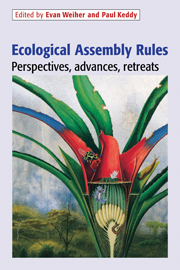Book contents
- Frontmatter
- Contents
- List of Contributors
- Introduction: The scope and goals of research on assembly rules
- Part I The search for meaningful patterns in species assemblages
- 1 The genesis and development of guild assembly rules
- 2 Ruling out a community assembly rule: the method of favored states
- 3 Community structure and assembly rules: confronting conceptual and statistical issues with data on desert rodents
- 4 Introduced avifaunas as natural experiments in community assembly
- 5 Assembly rules in plant communities
- 6 Assembly rules at different scales in plant and bird communities
- 7 Impact of language, history and choice of system on the study of assembly rules
- Part II Other perspectives on community assembly
- Index
7 - Impact of language, history and choice of system on the study of assembly rules
Published online by Cambridge University Press: 04 September 2009
- Frontmatter
- Contents
- List of Contributors
- Introduction: The scope and goals of research on assembly rules
- Part I The search for meaningful patterns in species assemblages
- 1 The genesis and development of guild assembly rules
- 2 Ruling out a community assembly rule: the method of favored states
- 3 Community structure and assembly rules: confronting conceptual and statistical issues with data on desert rodents
- 4 Introduced avifaunas as natural experiments in community assembly
- 5 Assembly rules in plant communities
- 6 Assembly rules at different scales in plant and bird communities
- 7 Impact of language, history and choice of system on the study of assembly rules
- Part II Other perspectives on community assembly
- Index
Summary
Introduction
Assembly rules provide a useful framework that allows ecologists to make predictions about community change and development over time. However, three features of the discussion about ecological assembly rules lessen its potential impact on ecologists and those who apply ecology to management. First, the current language of the idea has become unnecessarily complex. It is not always clear what researchers mean when they refer to assembly rules. Some argue that assembly rules only apply to biotic interactions (Wilson & Gitay, 1995) whereas others consider all constraints on community development (Keddy, 1992). Some workers look for rules that apply at the small scale, or to specific species distributions, whereas others look for larger, more general patterns (Drake et al., 1993).
Second, the current discussion appears to have little regard for the history or origin of work on the constraints on community development. Diamond (1975) is usually cited as having coined the phrase ‘assembly rule’, but in reality, many early ecologists such as Clements (1916, 1936) and Gleason (1917, 1926) addressed many of the questions currently being considered. By ignoring their work, we run the risk of reinventing ideas already well established in the literature.
Finally, the primary evidence used to develop and test ideas on assembly rules is often derived from complex ecosystems that do not necessarily follow simple trajectories (Drake, 1991).
- Type
- Chapter
- Information
- Ecological Assembly RulesPerspectives, Advances, Retreats, pp. 206 - 230Publisher: Cambridge University PressPrint publication year: 1999
- 17
- Cited by

